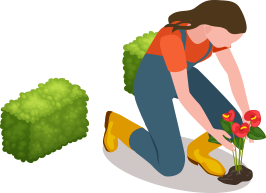Soft Lawn
Success with your lawn depends on many things. Not the least among them is growing the proper type of grass for your area. In general, northern areas grow cool season grasses and southern areas grow warm season varieties. The transition area is capable of growing both types with the proper care.Creeping grasses like bluegrass, Bermuda and most warm-season grasses spread by above- or below-ground runners. Creeping varieties are more prone to thatch.
Bunch grasses such as fescue and ryegrass spread from the crown of the plant. Mowing high protects the crown and ensures the survival of the grass.
The transition zone (green on the map) sometimes requires mixtures or blends of warm- and cool-season grasses. In general, the transition zone has more success with the cool-season grasses over the warm-season varieties.
If you’re like most people, your lawn is the highest use area of your landscaping, especially if you have kids or pets.
 ×
Compacted soil results in problems with air circulation, water drainage, and nutrient absorption. Additionally, beneficial soil organisms such as earth worms can’t establish in hard, compacted soil. If you want to really green up your grass and make your turf healthier and more beautiful, you should regularly aerate your lawn.
Lawn aeration simply means punching holes throughout your lawn to about 3 inches deep. With regular lawn aeration, you can help give your grass a proper medium to grow in, which loose soil and better air circulation. You grass will also make better use of water and nutrients. Additionally, micro-organisms will establish themselves in your soil and help break down any thatch that builds up. There are several different ways to aerate your lawn, either by renting a large aerating machine or by using a simple handheld aerating tool. For most homeowners with small to medium sized lawns, a handheld aerating tool will do the trick. You should aerate your lawn about once a year.
×
Compacted soil results in problems with air circulation, water drainage, and nutrient absorption. Additionally, beneficial soil organisms such as earth worms can’t establish in hard, compacted soil. If you want to really green up your grass and make your turf healthier and more beautiful, you should regularly aerate your lawn.
Lawn aeration simply means punching holes throughout your lawn to about 3 inches deep. With regular lawn aeration, you can help give your grass a proper medium to grow in, which loose soil and better air circulation. You grass will also make better use of water and nutrients. Additionally, micro-organisms will establish themselves in your soil and help break down any thatch that builds up. There are several different ways to aerate your lawn, either by renting a large aerating machine or by using a simple handheld aerating tool. For most homeowners with small to medium sized lawns, a handheld aerating tool will do the trick. You should aerate your lawn about once a year.
 ×
×
 ×
Turning your sprinkler on for just a few minutes a few times a week really won’t do much to help your lawn. For a healthier lawn, learn to water your grass deeply and less often. If you water infrequently and deeply, the roots of your grass will start to grow deeper down into the soil. This helps your grass stay green during periods of drought or extremely hot weather. Experts recommend that you water your grass with 1 inch of water, once a week. This amount of course can vary depending on your local weather conditions, soil type, grass species, etc.
How do you know if you’re watering your plants with 1 inch of water? You can use this simple test. Place a series of shallow containers throughout your lawn and turn your sprinklers on. Keep watering until you measure 1 inch of water in the majority of the containers.
garden
green
lawn
×
Turning your sprinkler on for just a few minutes a few times a week really won’t do much to help your lawn. For a healthier lawn, learn to water your grass deeply and less often. If you water infrequently and deeply, the roots of your grass will start to grow deeper down into the soil. This helps your grass stay green during periods of drought or extremely hot weather. Experts recommend that you water your grass with 1 inch of water, once a week. This amount of course can vary depending on your local weather conditions, soil type, grass species, etc.
How do you know if you’re watering your plants with 1 inch of water? You can use this simple test. Place a series of shallow containers throughout your lawn and turn your sprinklers on. Keep watering until you measure 1 inch of water in the majority of the containers.
garden
green
lawn

A Small Cottage Garden
PrevFront Yard Landscaping
Next

Your Garden Needs a Bit of Love? Contact Us Now!
CONTACT US